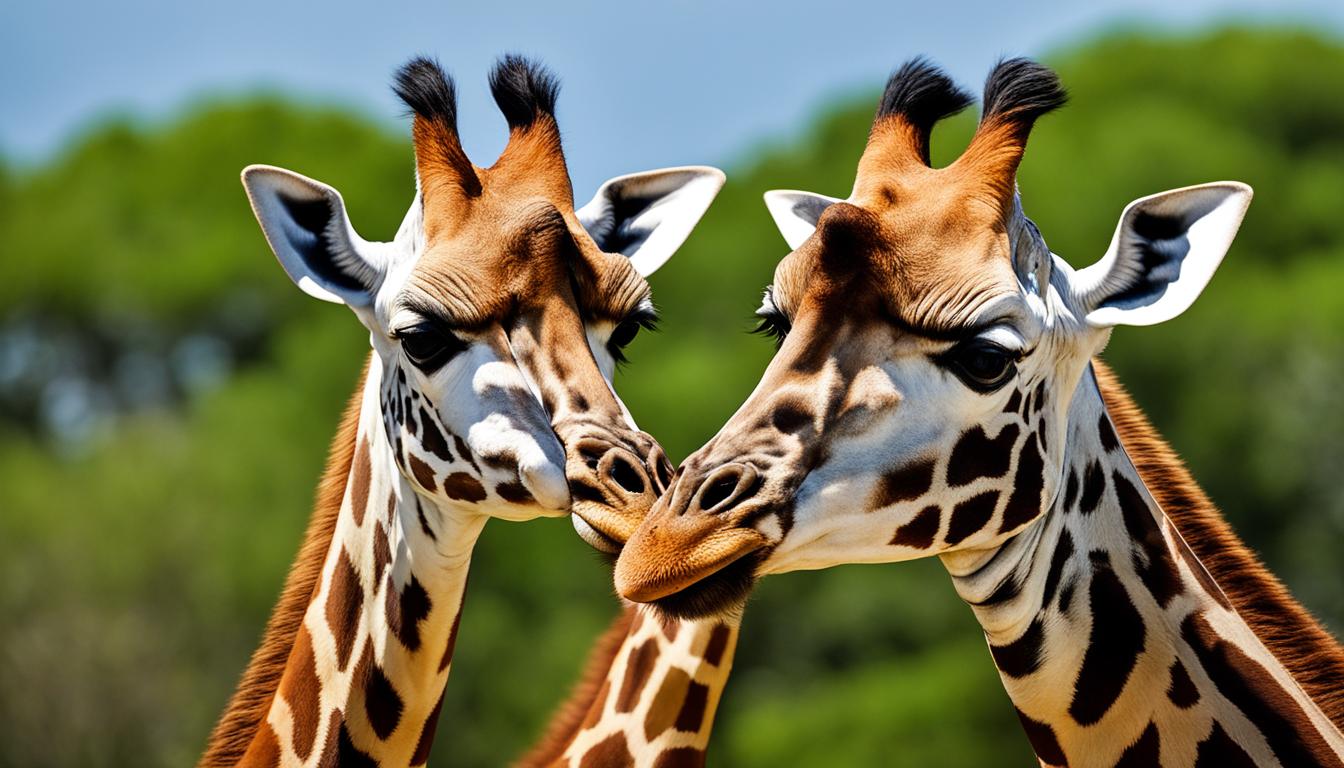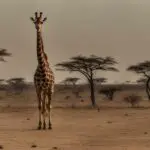Giraffes are often seen as silent animals, but they have unique ways of communicating with each other. While they don’t make a lot of sound, giraffes use non-verbal communication through body language and touch. They live in herds of 10 to 12 members, and it’s essential for them to be able to communicate effectively. Giraffes can direct other members’ attention to potential danger by paying attention to body posture, eyes, and sometimes by touching each other. During mating season, males make coughing sounds to attract females, and mothers make hissing or whistling sounds to warn their young about danger.
Giraffe Vocalizations
While giraffes are generally quiet animals, they do make some vocalizations. Recent studies have shown that giraffes can produce long sustained vocalizations, resembling a humming sound. These vocalizations were detected during the night in European zoos. The humming sound is an organized sound with a pattern and is believed to be a way for giraffes to signal each other in the dark when vision is limited. This form of vocal communication is still being studied, and researchers are trying to understand its purpose and significance within giraffe herd dynamics.
Giraffe vocalizations provide valuable insights into their communication patterns. The humming sound, with its distinct pattern, suggests a complex system of signals used by giraffes in various social contexts. By analyzing the vocalizations, researchers hope to uncover the meaning behind different patterns and the specific messages they convey. This research will contribute to a deeper understanding of giraffe communication and shed light on their intricate social dynamics.
Although giraffes are known for their towering height, their vocalizations reveal a more subtle aspect of their behavior. The humming sounds demonstrate that communication among giraffes is not limited to visual cues or physical interactions alone. Instead, vocalizations play a crucial role in their everyday interactions, allowing them to navigate their environment and maintain social cohesion within the herd.
Giraffe Communication Signals
Within giraffe vocalizations, researchers have identified specific signals that giraffes use to convey different messages. These signals can vary in duration, pitch, and intensity, providing a rich repertoire of vocal communication patterns. Understanding these signals can help decipher the intricacies of giraffe language and shed light on their social interactions.
A comprehensive table of giraffe vocalization signals:
| Signal | Description |
|---|---|
| Humming Sound | A sustained vocalization resembling a low-frequency humming. Believed to be used for signaling in low-light conditions. |
| Coughing Sound | Male giraffes produce cough-like sounds during mating season to attract females. |
| Hissing/Whistling Sound | Mother giraffes make hissing or whistling sounds to warn their young about potential danger. |
The table provides an overview of the different vocal signals giraffes use to communicate with each other. Each signal serves a specific purpose within their social dynamics, ensuring effective communication and coordination within the herd.
Giraffe Body Language
Giraffes have a unique way of communicating with each other through their body language. They use various physical signals to convey emotions, establish dominance, and warn each other of potential danger. One of the most striking aspects of giraffe body language is their use of prolonged stares. They can use their eyes to communicate messages, such as warning predators to stay away from their young calves or alerting other herd members of nearby threats.

Another fascinating behavior exhibited by giraffes is “necking”. This is a form of sparring between male giraffes, where they stand with their feet spread apart and wrap or rub their necks with each other. It is a way for them to establish dominance within the herd. While giraffes are not known for their physical touch like elephant families, mother giraffes may nuzzle and stroke their calves to show affection or train them in finding food or avoiding danger.
Giraffes have a complex social behavior, and their body language plays a crucial role in maintaining herd dynamics. By understanding their non-verbal cues and gestures, researchers can gain insights into the social structure and communication methods of these majestic creatures.
Giraffe Body Language
| Body Language Signal | Meaning |
|---|---|
| Prolonged stares | Warning predators or alerting herd members of danger |
| “Necking” behavior | Establishing dominance within the herd |
| Nuzzling and stroking | Showing affection and training young calves |
Through their body language, giraffes are able to communicate and navigate their social interactions. By studying these gestures and signals, researchers can continue to unravel the fascinating world of giraffe social behavior and communication methods.
Giraffe Communication Research
Giraffe communication has been a subject of extensive research as scientists strive to unravel the complexities of their language and communication methods. Recent studies have shed light on the unique ways in which giraffes communicate, including vocalizations and body language.
One particular area of research focuses on giraffe vocalizations. Giraffes are generally quiet animals, but studies have discovered that they can produce vocalizations in the audible range through humming. These organized humming sounds are believed to serve as a means of communication, especially in dark environments where vision is limited. Researchers are still delving into the purpose and significance of these vocalizations within giraffe herds, hoping to gain a deeper understanding of their communication patterns.
Another area of interest in giraffe communication research is the study of body language. Giraffes rely heavily on non-verbal cues to convey messages and establish dominance. They use their eyes to communicate various emotions and warnings, such as prolonged stares to keep predators at bay or signal danger to other herd members. Additionally, behaviors like “necking” between male giraffes play a role in establishing social hierarchies and relationships.
With ongoing research, scientists aim to uncover more insights into giraffe communication methods. By studying vocalizations, body language, and other communication signals, researchers hope to gain a comprehensive understanding of how giraffes communicate within their herds and with other members of their species. This knowledge will contribute to our overall understanding of giraffe social behavior and further emphasize the fascinating nature of their communication.
Giraffe Communication Research Highlights
- Studies have revealed that giraffes can produce vocalizations through humming, which serves as a means of communication.
- Giraffes rely heavily on non-verbal cues, such as eye contact and body language, to convey messages and establish dominance.
- Research on giraffe communication aims to uncover the purpose and significance of vocalizations and body language within giraffe herds.
- Scientists are striving to gain a comprehensive understanding of giraffe communication methods and their role in social behavior.
Continued research in this field holds promise for uncovering further insights into the captivating world of giraffe communication, expanding our knowledge of these graceful creatures and their intricate social dynamics.
Conclusion
Discovering how giraffes communicate is a captivating journey into their social behavior. Despite their reputation as quiet animals, giraffes have developed unique ways to convey messages and maintain order within their herds. Through body language, vocalizations, and touch, giraffes effectively communicate important information about potential dangers, mating rituals, and nurturing their young.
Scientists have delved into the world of giraffe communication, uncovering fascinating insights. They have observed that giraffes use prolonged stares and specific postures to signal warnings to predators or alert other herd members. Vocalizations, such as the humming sounds detected in European zoos, serve as a distinct form of communication, particularly in low-light conditions.
Ongoing research continues to shed light on giraffe communication methods and language. By understanding the intricate social dynamics of these majestic creatures, scientists can gain a deeper appreciation for the complex web of interactions within giraffe herds. The study of giraffe communication opens up new avenues of knowledge, enhancing our understanding of their remarkable species.
What are the different sounds that giraffes use to communicate?
Giraffes use a variety of vocalizations and non-verbal cues as part of their giraffes communication methods. They produce low-frequency sounds, often referred to as infrasounds, that are thought to travel through the ground. These sounds can convey information about reproductive states or serve as warning signals. Giraffes also communicate through body language, such as neck movements and postures, to maintain social bonds and establish dominance within their herd.
FAQ
How do giraffes communicate with each other in the wild?
Giraffes communicate through body language, vocalizations, and touch. They use their eyes, body postures, and sometimes touch each other to convey messages and warn each other of potential danger.
What are giraffe vocalizations?
Giraffes can produce long sustained vocalizations resembling a humming sound. These vocalizations are believed to be a way for giraffes to signal each other in the dark when vision is limited.
How do giraffes use body language to communicate?
Giraffes use their eyes to convey emotions and messages. Prolonged stares can be used to warn predators or signal danger to other herd members. They also engage in “necking” behavior to establish dominance.
What is “necking” in giraffes?
“Necking” is a form of sparring between male giraffes where they wrap or rub their necks with each other. It is a way for them to establish dominance.
What do researchers know about giraffe communication?
Giraffe communication is a topic of ongoing research. Scientists are studying vocalizations, body language, and touch to understand the purpose and meaning behind these communication methods.










